Walking a Few Steps Behind Marco Polo
Imagine that you could travel back in time a 1000 years - or that you could jump back 3000 years? That’s exactly what we did in Uplistsikhe, Georgia!
|
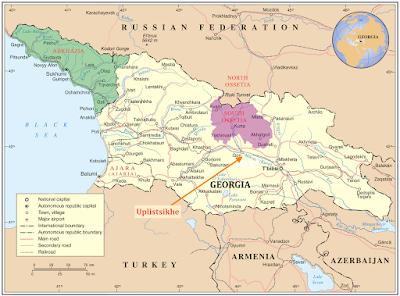
|
|
Map of Georgia. Public Domain: https://en.wikipedia.org/wiki/Georgia_%28country%29
|
Uplistsikhe means “the lord’s fortress,” and it stands high above the Mtkvari River in central Georgia. What’s special about the Mtkvari River? It was part of “highway” of the Silk Route, the long, long road that wound all the way from China to Western Europe. You’ll find the town and river just outside Gori.
Imagine:
Walking through Uplistsikhe meanswalking over the same path that Marco Polo may have walked!
Sadly, the town is now in ruins, but it’s not hard to learn what it might have been like when an ancient trader stopped in for a rest.
He would have seen the town above him as he traveled on the river, and then he would have gotten out of his boat and strode up an elegant, awning-covered path to enter Uplistsikhe. We know the road had an airy covering because we can still see the holes bored in the rock to hold the canopy poles.
|
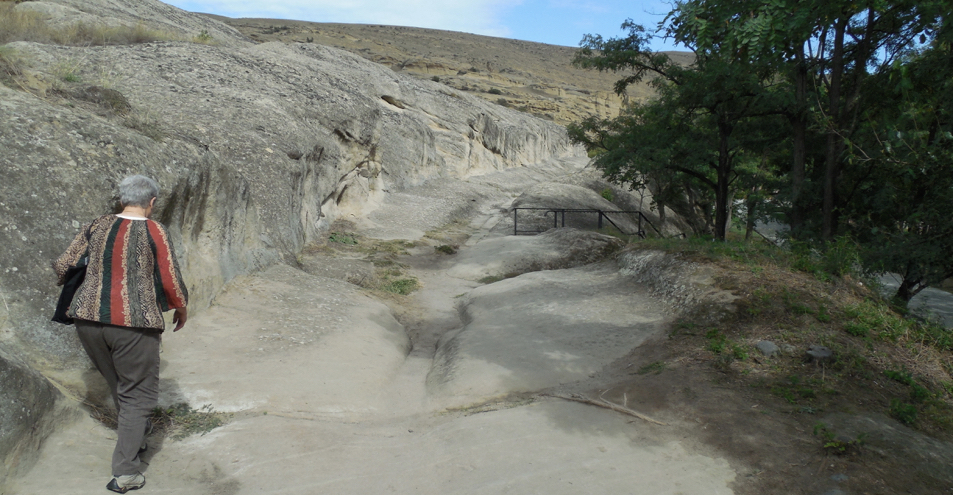
|
|
The ruins of the path leading into ancient Uplistsikhe
|
One of the reasons the town is still somewhat intact after 3000 years is that it was not built of wood, brick, or even stones. Uplistsikhe was a town that was CARVED out of rock. So as traders entered the town, they would have seen - just to the side of the entrance road - the stalls of merchants that had been carved into the rock.
|
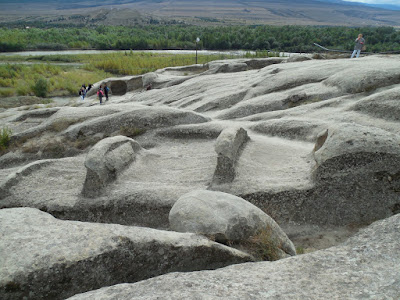
|
|
The divisions between merchants stalls that remain next to the path into the town
|
Further into town they could have found the apothecary’s shop, the soldier’s quarters, and the courtroom. The space the court occupied is still quite clear, and behind the courtroom is the jail for prisoners. It seems that prisoners in Uplistsikhe may not have stayed in jail for long, because right next to the prison is a small execution area.
|
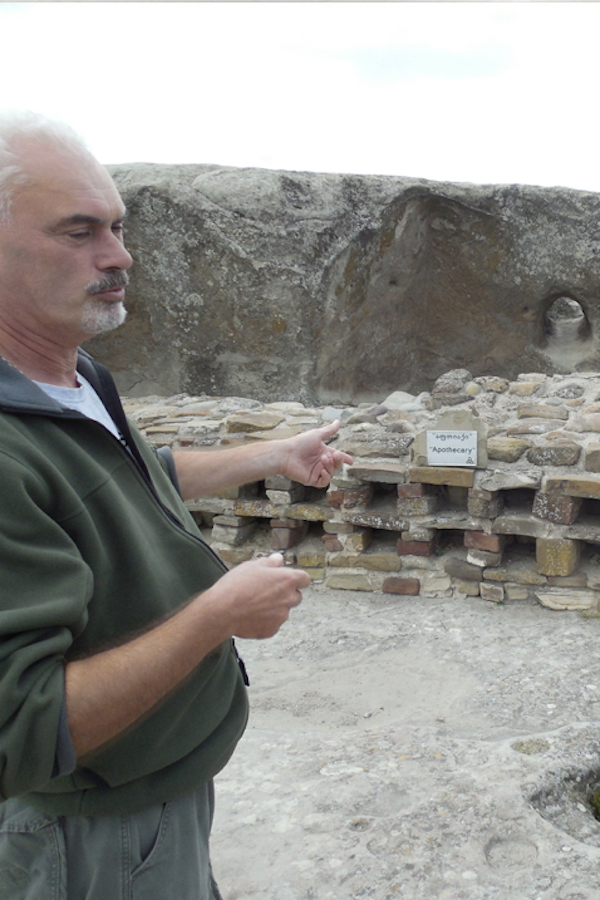
|
|
Apothecary's shop
|
Uplistsikhe catered to merchants coming from all directions, and when they arrived they could find a spacious restaurant, and even a small theatre. But that was not the only kind of accommodations the town made for its visitors. It also served their religious inclinations and included a temple to Apollo, another to Mithra, and others.
|
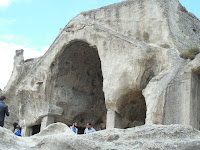
|
|
Theater side eview
|
|
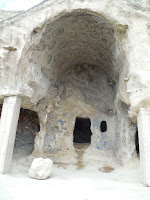
|
|
Theater front view
|
|
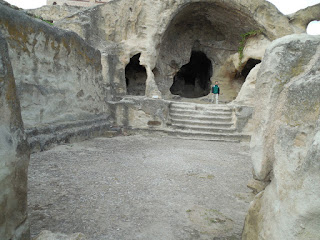
|
|
Temple
|
At the crest of the town - carved from the same sandstone rock - was the palace of the king and the queen. They had the luxury of having separate palaces, and one can still take a seat in the throne room.
|
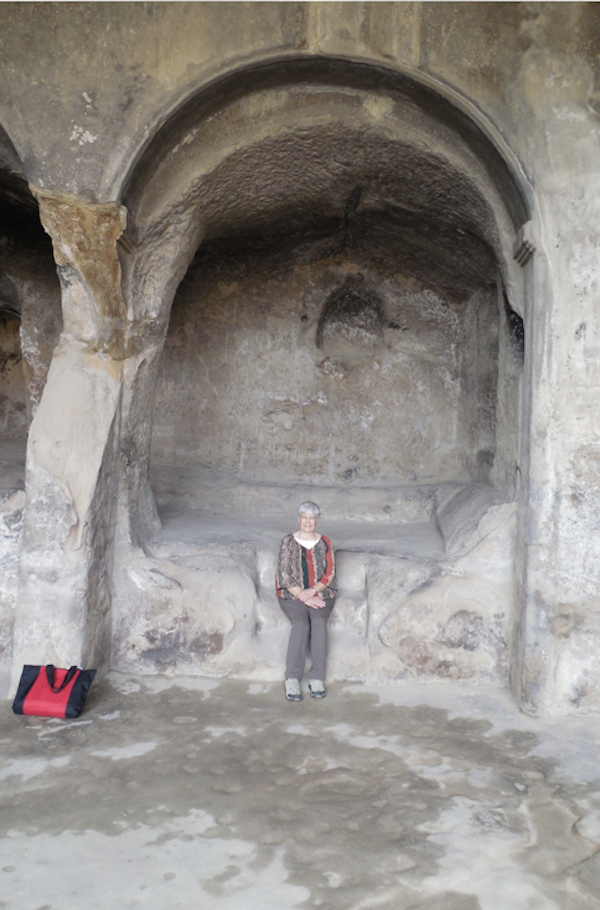
|
|
The throne room
|
One of the most surprising features of the buildings is that they are carved to imitate the ornamental features one might have found in Rome. Here you can see some of the columns and ceiling ornaments.
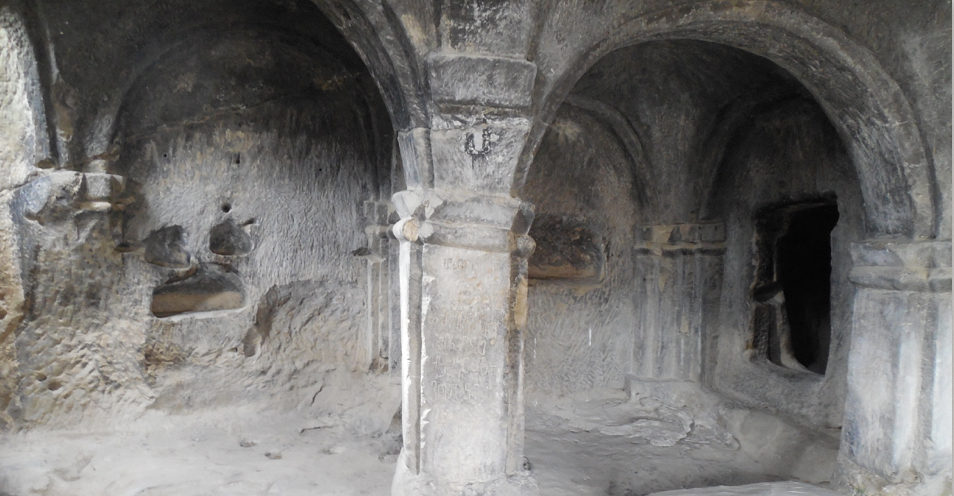
Columns

Ceiling
When the town converted to Christianity, around the 8th century, a basilica was built, not by carving it, but by building it one stone at a time.
But as you can see, the town is no more. The Mongol invasions of the 13th and 14th centuries brought an end to this prospering town carved out of rock. Much of the original grandeur has been eroded by time, but we can still get a pretty good idea of what a visit to Uplistsikhe might have been like for Marco Polo - if he managed to get there before the Mongols did!
Learn about another country that Marco Polo visited with this art lesson for kids!
Imagine that you could travel back in time a 1000 years - or that you could jump back 3000 years? That’s exactly what we did in Uplistsikhe, Georgia!
|

|
|
Map of Georgia. Public Domain: https://en.wikipedia.org/wiki/Georgia_%28country%29
|
Uplistsikhe means “the lord’s fortress,” and it stands high above the Mtkvari River in central Georgia. What’s special about the Mtkvari River? It was part of “highway” of the Silk Route, the long, long road that wound all the way from China to Western Europe. You’ll find the town and river just outside Gori.
Imagine:
Walking through Uplistsikhe meanswalking over the same path that Marco Polo may have walked!
Sadly, the town is now in ruins, but it’s not hard to learn what it might have been like when an ancient trader stopped in for a rest.
He would have seen the town above him as he traveled on the river, and then he would have gotten out of his boat and strode up an elegant, awning-covered path to enter Uplistsikhe. We know the road had an airy covering because we can still see the holes bored in the rock to hold the canopy poles.
|

|
|
The ruins of the path leading into ancient Uplistsikhe
|
One of the reasons the town is still somewhat intact after 3000 years is that it was not built of wood, brick, or even stones. Uplistsikhe was a town that was CARVED out of rock. So as traders entered the town, they would have seen - just to the side of the entrance road - the stalls of merchants that had been carved into the rock.
|

|
|
The divisions between merchants stalls that remain next to the path into the town
|
Further into town they could have found the apothecary’s shop, the soldier’s quarters, and the courtroom. The space the court occupied is still quite clear, and behind the courtroom is the jail for prisoners. It seems that prisoners in Uplistsikhe may not have stayed in jail for long, because right next to the prison is a small execution area.
|

|
|
Apothecary's shop
|
Uplistsikhe catered to merchants coming from all directions, and when they arrived they could find a spacious restaurant, and even a small theatre. But that was not the only kind of accommodations the town made for its visitors. It also served their religious inclinations and included a temple to Apollo, another to Mithra, and others.
|

|
|
Theater side eview
|
|

|
|
Theater front view
|
|

|
|
Temple
|
At the crest of the town - carved from the same sandstone rock - was the palace of the king and the queen. They had the luxury of having separate palaces, and one can still take a seat in the throne room.
|

|
|
The throne room
|
One of the most surprising features of the buildings is that they are carved to imitate the ornamental features one might have found in Rome. Here you can see some of the columns and ceiling ornaments.

Columns

Ceiling
When the town converted to Christianity, around the 8th century, a basilica was built, not by carving it, but by building it one stone at a time.
But as you can see, the town is no more. The Mongol invasions of the 13th and 14th centuries brought an end to this prospering town carved out of rock. Much of the original grandeur has been eroded by time, but we can still get a pretty good idea of what a visit to Uplistsikhe might have been like for Marco Polo - if he managed to get there before the Mongols did!
Learn about another country that Marco Polo visited with this art lesson for kids!
Imagine that you could travel back in time a 1000 years - or that you could jump back 3000 years? That’s exactly what we did in Uplistsikhe, Georgia!
|

|
|
Map of Georgia. Public Domain: https://en.wikipedia.org/wiki/Georgia_%28country%29
|
Uplistsikhe means “the lord’s fortress,” and it stands high above the Mtkvari River in central Georgia. What’s special about the Mtkvari River? It was part of “highway” of the Silk Route, the long, long road that wound all the way from China to Western Europe. You’ll find the town and river just outside Gori.
Imagine:
Walking through Uplistsikhe meanswalking over the same path that Marco Polo may have walked!
Sadly, the town is now in ruins, but it’s not hard to learn what it might have been like when an ancient trader stopped in for a rest.
He would have seen the town above him as he traveled on the river, and then he would have gotten out of his boat and strode up an elegant, awning-covered path to enter Uplistsikhe. We know the road had an airy covering because we can still see the holes bored in the rock to hold the canopy poles.
|

|
|
The ruins of the path leading into ancient Uplistsikhe
|
One of the reasons the town is still somewhat intact after 3000 years is that it was not built of wood, brick, or even stones. Uplistsikhe was a town that was CARVED out of rock. So as traders entered the town, they would have seen - just to the side of the entrance road - the stalls of merchants that had been carved into the rock.
|

|
|
The divisions between merchants stalls that remain next to the path into the town
|
Further into town they could have found the apothecary’s shop, the soldier’s quarters, and the courtroom. The space the court occupied is still quite clear, and behind the courtroom is the jail for prisoners. It seems that prisoners in Uplistsikhe may not have stayed in jail for long, because right next to the prison is a small execution area.
|

|
|
Apothecary's shop
|
Uplistsikhe catered to merchants coming from all directions, and when they arrived they could find a spacious restaurant, and even a small theatre. But that was not the only kind of accommodations the town made for its visitors. It also served their religious inclinations and included a temple to Apollo, another to Mithra, and others.
|

|
|
Theater side eview
|
|

|
|
Theater front view
|
|

|
|
Temple
|
At the crest of the town - carved from the same sandstone rock - was the palace of the king and the queen. They had the luxury of having separate palaces, and one can still take a seat in the throne room.
|

|
|
The throne room
|
One of the most surprising features of the buildings is that they are carved to imitate the ornamental features one might have found in Rome. Here you can see some of the columns and ceiling ornaments.

Columns

Ceiling
When the town converted to Christianity, around the 8th century, a basilica was built, not by carving it, but by building it one stone at a time.
But as you can see, the town is no more. The Mongol invasions of the 13th and 14th centuries brought an end to this prospering town carved out of rock. Much of the original grandeur has been eroded by time, but we can still get a pretty good idea of what a visit to Uplistsikhe might have been like for Marco Polo - if he managed to get there before the Mongols did!
Learn about another country that Marco Polo visited with this art lesson for kids!







